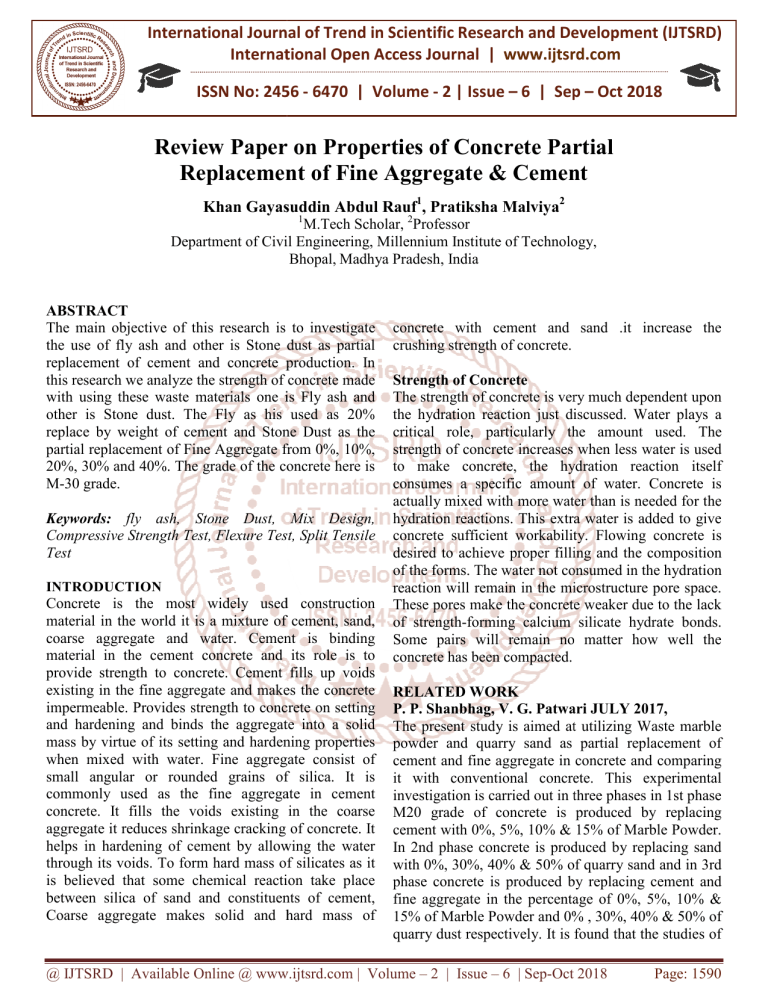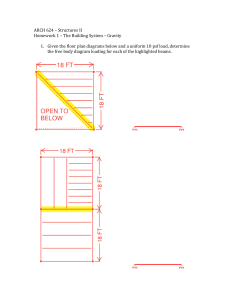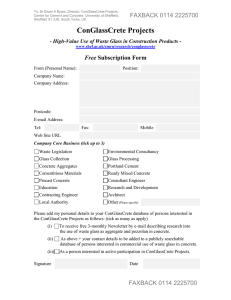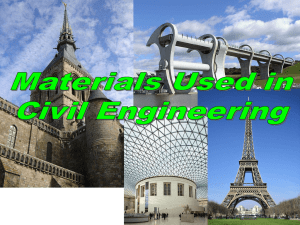
International Journal of Trend in Scientific Research and Development (IJTSRD)
International Open Access Journal | www.ijtsrd.com
ISSN No: 2456 - 6470 | Volume - 2 | Issue – 6 | Sep – Oct 2018
Review Paper on Properties of Concrete Partial
Replacement ooff Fine Aggregate & Cement
Khan Gayasuddin Abdul Rauf1, Pratiksha Malviya2
1
M.Tech Scholar, 2Professor
Department of Civil Engineering
Engineering, Millennium Institute of Technology,
Technology
Bhopal, Madhya Pradesh, India
ABSTRACT
The main objective of this research is to investigate
the use of fly ash and other is Stone dust as partial
replacement of cement
ement and concrete production. In
this research we analyze the strength of concrete made
with using these waste materials one is Fly ash and
other is Stone dust. The Fly as his used as 20%
replace by weight of cement and Stone Dust as the
partial replacement
nt of Fine Aggregate from 0%, 10%,
20%, 30% and 40%. The grade of the concrete here is
M-30 grade.
Keywords: fly ash, Stone Dust, Mix Design,
Compressive Strength Test, Flexure Test, Split Tensile
Test
INTRODUCTION
Concrete is the most widely used construction
material in the world it is a mixture of cement, sand,
coarse aggregate and water. Cement is binding
material in the cement concrete and its role is to
provide strength to concrete. Cement fills up voids
existing in the fine aggregate and make
makes the concrete
impermeable. Provides strength to concrete on setting
and hardening and binds the aggregate into a solid
mass by virtue of its setting and hardening properties
when mixed with water. Fine aggregate consist of
small angular or rounded grains of silica. It is
commonly used as the fine aggregate in cement
concrete. It fills the voids existing in the coarse
aggregate it reduces shrinkage cracking of concrete. It
helps in hardening of cement by allowing the water
through its voids. To form hard mass
ss of silicates as it
is believed that some chemical reaction take place
between silica of sand and constituents of cement,
Coarse aggregate makes solid and hard mass of
concrete with cement and sand .it increase the
crushing strength of concrete.
Strength of Concrete
The strength of concrete is very much dependent upon
the hydration reaction just discussed. Water plays a
critical role, particularly the amount used. The
strength of concrete increases when less water is used
to make concrete, the hydration
hy
reaction itself
consumes a specific amount of water. Concrete is
actually mixed with more water than is needed for the
hydration reactions. This extra water is added to give
concrete sufficient workability. Flowing concrete is
desired to achieve proper
oper filling and the composition
of the forms. The water not consumed in the hydration
reaction will remain in the microstructure pore space.
These pores make the concrete weaker due to the lack
of strength-forming
forming calcium silicate hydrate bonds.
Some pairss will remain no matter how well the
concrete has been compacted.
RELATED WORK
P. P. Shanbhag, V. G. Patwari JULY 2017,
The present study is aimed at utilizing Waste marble
powder and quarry sand as partial replacement of
cement and fine aggregate in concrete and comparing
it with conventional concrete. This experimental
investigation is carried out in three phases in 1st phase
p
M20 grade of concrete is produced by replacing
cement with 0%, 5%, 10% & 15% of Marble Powder.
In 2nd phase concrete is produced by replacing sand
with 0%, 30%, 40% & 50% of quarry sand and in 3rd
phase concrete is produced by replacing cement and
finee aggregate in the percentage of 0%, 5%, 10% &
15% of Marble Powder and 0% , 30%, 40% & 50% of
quarry dust respectively. It is found that the studies of
@ IJTSRD | Available Online @ www.ijtsrd.com | Volume – 2 | Issue – 6 | Sep-Oct
Oct 2018
Page: 1590
International Journal of Trend in Scientific Research and Development (IJTSRD) ISSN: 2456-6470
2456
concrete made of waste marble powder and quarry
sand increases at 10% and 40% respectively.
Therefore the
he quarry dust and waste marble powder
should be used in construction works, then the cost of
construction would be saved significantly and the
natural resources would be used efficiently.
Mohammadreza Mirzahosseini and Kyle A. Riding
June 2015,
Have examined that the finely ground glass hs the
potential for pozzolanic reactivity and can fill in as a
supplementary cementitious material uniform
structure, amorphous nature, and high silica content
influenced ground to glass perfect for concentrate the
impacts
mpacts of glass write and molecule estimate on
smooth material reactivity at various temperature.
This investigation centres around how the blend of
glass composes and particles sizes influences the
microstructure and execution properties of
cementitious framework containing glass cullet as a
supplementary cementitious materials. They found
that the response rate pozzolanicity and hydration
degree capability of four arrangements of
consolidated glass composes and sizes were examined
utilizing
isothermal
calorimetric
concoction
shrinkage, thermo gravimetric investigation and
examination of checking electron magnifying lens
pictures,
es, additionally compressive quality and water
sorptivity were performed on mortar tests to connect
reactivity of cementitious materials containing glass
to the execution of cementitious blends. Results
demonstrated that joined glass can expands response
rate
ate and show pozzolanic properties, particularly
when particles of clear and green glass underneath 25
micron were utilized at a curing temperature of 50
degree Celsius. The synchronous impact of sizes and
kinds of glass cullet (surface zone) on response rrate of
Glass Powder additionally can be represented through
a straight option mirroring that the surface territory
would fundamentally influence glass cullet reactivity.
However execution properties a cementitious
framework containing joined glass writes aand measure
carried on diversely as they took after the weaker
segment of the two particles.
Brajesh Kumar Suman, Vikas Sribastava. April
2015.
Have considered that the stone tidy is such an elective
material which can be adequately being utilized as a
part
art of development as halfway substitution of normal
sand. In this examination, a test program was
completed to think about the reasonableness and
potential utilization of stone clean as incomplete
substitution of fine total in concrete. To achieve this
example
ample were thrown for various substitution level at
an interim of % to decide workability and
compressive quality of cement at various level of fine
total with stone tidy. Results demonstrate that ideal
supplanting with stone tidy is 60% in light of
compressive quality.
Arame Niang, Nathaliee Roy, and Arezki TagnitTagnit
Homou March 2015,
Have contemplated that Concrete created by utilizing
Glass Powder as a fastener demonstrates low
piousness to chloride particles. Furthermore, broad
research venture on the utilization of Glass Powder as
cementitious material is in progress at the college of
Sherbrook, Quebec, Canada. The north-eastern
Canadian region of Quebec has a strategy on squander
administration to advance the recuperation and
administration of materials
ls from the city, modern,
business and institutional divisions. In this way new
options for utilizing reused glass are required. Glass
Powder contains around 70% silicon dioxide. In this
manner the supplanting of 20% of bond with the
consolidation of Glass Powder into the detailing of
cement gives monetary and natural advantages.
Besides, it has been demonstrated that solid with 20%
Glass Powder has a low penetrability to chloride
particles, which makes it an appropriate answer for
reinfor4ced solid components
nts subject to eroding
condition, for example, deicing items or a salty
climate. The outcomes from an investigation on the
auxiliary conduct of strengthened solid section
consolidating Glass Powder. The solid section made
with Glass Powder indicate attractive
attract
basic conduct.
The outcomes demonstrated that for a water-folio
water
proportion of 0.4 the substitution of 20% of bond by
Glass Powder postponed breaking o the solid cover
and marginally enhanced the heap conveying limit.
For water-folio
folio ration0.55 the outcomes
outc
for segments
with Glass Powder tried at 91 days were still
somewhat lower than those without Glass Powder. In
any case, the distinction was littler than for sections
with a similar water-cover
cover proportion that were tried
at 28 days. Generally, the outcomes
outc
demonstrated that
auxiliary conduct of fortified solid segments made
utilizing concrete with Glass Powder is like section
made with ordinary cement with 20% Glass Powder
for the development of practical building structures.
Dr. Lalit Kumar, Er. Arvinder
Arvi
Singh. January
2015.
Have examine the likelihood of utilizing pounded
stone tidy as fine total incompletely or completely
@ IJTSRD | Available Online @ www.ijtsrd.com | Volume – 2 | Issue – 6 | Sep-Oct
Oct 2018
Page: 1591
International Journal of Trend in Scientific Research and Development (IJTSRD) ISSN: 2456-6470
2456
with various evaluations of solid composites. The
reasonableness of smashed stone tidy waste as a fine
total for concrete has beenn surveyed by contrasting its
fundamental properties and that of traditional cement.
Two essential blends were decided for regular sand to
accomplish M25 and M30 review concrete. The
comparable blends were acquired by supplanting
regular sand by stone tidy mostly and completely. The
test outcome demonstrates the smashed stone tidy can
be utilized viably to supplant characteristic sand in
concrete. In the exploratory investigation of quality
attributes of solid utilizing smashed stone tidy as fine
total it is discovered that there is increment in
compressive quality, flexure quality and elasticity.
Sadoon Abdallah, Mizi Fan June 2014.
Have examines that the attributes of cement
containing fine pulverized glass amid its procedure,
the best proportion of fine
ine squashed glass which
prompts higher quality of cement with a specific end
goal to create solid squares, and the impacts of waste
glass substitution on extension caused by Alkali
Alkali-Silica
response. The droop unit weight, compressive quality
part rigidity, flexure quality modulus of flexibility,
ultrasonic heartbeat speed, dry thickness, water
retention and Alkali-Silica
Silica response were examined as
far as waste glass content (0%, 5%, 15% and 20%)
under various curing age of 7, 14, and 28 days. It was
discovered
ed that the droop of cement containing waste
glass as fine total supplanting diminished with
expanded in the waste glass however without loss of
workability. The compressive, part ductile and flexure
quality of cement with 20% waste glass content
expanded by 5.28%, 18.38% and 8.92% separately at
28 days. The coxes with squander glass substitution
demonstrated a denser inside solid structure or more
steady structure under ultrasonic heartbeat speed
evaluation. There was a reasonable diminished in the
water retention
etention with an increment of waste glass total
proportion, and an unmistakable decrease in the
development of the waste glass solid, demonstrating a
soluble base silica response in solid which happened
between the dynamic silica of waste glass and silica
of concrete glue.
Ali A. Aliabdo, Abd Elmoaty M. Abd Elmoaty,
Esraa M. Auda. January 2014,
Have discover the utilization of marble clean in solid
creation as bond substitution or as sand substitution
(bond expansion) continuously improves both of the
Mechanical
anical and Physical properties of cement
particularly with bring down w/c proportion. Marble
clean demonstrated a filler impact in concrete and had
no recognizable part in the hydration procedure.
However concrete made with marble tidy as sand
substitution accomplished better execution contrasted
with concrete made with marble tidy as bond
substitution.
M. Vijayalakshmi, A. S. S. Sekar., G. Ganesh
PrabhuSeptember 2013,
Have examined that the rock stone handling industry
produces huge amounts of non-biodegradable fine
powder squanders and usage of that risky waste in
solid generation will prompt green condition and
reasonable solid innovation. Solid blend were set up
by 0%, 5%, 10%, 15%, 20% and 25% of fine total
substituted by stone powder squander.
squand The acquired
test outcomes were demonstrated that the substitution
of regular sand by rock powder squander up to 15% of
any definition is good for the solid making without
antagonistically influencing the quality and strength
criteria. Notwithstanding it is prescribed that the rock
powder waste ought to be subjected to a compound
blanching process preceding mix in the solid to build
the sulfate protection.
Dr. G. Vijayakumar, Ms H. Vishliny, Dr. D.
Govindarajulu Feb 2013
Have contemplated that finely powdered waste
glasses are utilized as a fractional substitution of bond
in concrete and contrasted it and regular cement. This
work looks at that the likelihood of utilizing Glass
Powder as a fractional substitution as 10%, 20%, 30%
and 40%. What's more, tried for its compressive,
ductile and flexure quality up to 60 days of age and
were contrasted and those of traditional solid: frame
the outcomes acquired, it is discovered that Glass
Powder can be utilized as bond substitution material
upto molecule measure
ure under 75 micron to avoid salt
silica response.
Kalingarani et al. (2012)
concluded that Interlocking concrete paver block
(ICPB) is having advantages in the exterior flooring.
His aim of the study is making ICPB by using a
maximum amount of industrial waste like fly ash and
copper slag.
Vaz Aaron et al. (2012)
found that now a days cement concrete is second
mostly used commodity material in the world,
because cement is responsible for producing a large
amount of carbon dioxide & also responsible
respon
for
@ IJTSRD | Available Online @ www.ijtsrd.com | Volume – 2 | Issue – 6 | Sep-Oct
Oct 2018
Page: 1592
International Journal of Trend in Scientific Research and Development (IJTSRD) ISSN: 2456-6470
2456
global warming effect. Now a dyas Geopolymer
concrete used as an option for OPC in precast
concrete products. Geopolymer concrete is a eco
friendly option for waste stabilization. Geopolymer
concrete paver blocks have advantages on OPC in
form of high compressive strength. They also have
high early strength gain curing time 24hours at 60°C
and OPC is curing 28 days in water so geopolymer
concrete used Benefit in the manufacture paver block.
Problem Identification
Natural resources are depending past researches
for substitute construction materials is being done
rapidly.
Some of factory serape, garbage's by products are
useful as substitute for natural resources .Such
materials cause additional problems of storage,
environmental eco and transportation
rtation as well
literature survey indicated those glass ,serape of a
glass factory can be used as substitute material for
fine aggregate.
Glass powder is generated in a large amount in the
production of glass industries and crusher plants,
window repair shops, old tube light, electric bulb
etc.
Objective
To find out alternative materials as partial
replacement of cement and fine aggregate (sand).
To check the workability of the concrete by
adding fly ash and stone dust.
CONCLUSION
The compressive strength of the concrete by replacing
the 40% sand by stone dust and 20% cement by the
fly ash the strength increases.
REFERENCES
1. Ahmed
Omran,
Arezki
Tagnit
Tagnit-Hamou.
“Performance of glass-powder
powder concrete in field
applications”, Construction and Building Ma
Material.
Volume-109,
109, 15 April 2016, Pages 84
84-95.
2. Ali A. Aliabdo, Abd Elmoaty M. Abd Elmoaty,
Esraa M. Auda. “Re-use of waste marble dust in
the production of cement and concrete”,
Construction and Building Materials, Volume 50,
15 January 2014,, Pages 28-41.
3. Arame Niang, Nathalie Roy, and Arezki TagnitTagnit
Homou. “Structural Behaviour of Concrete
Incorporating Glass Powder Used in Reinforced
Concrete Columns”, Journal of Structural
Engineering. ASCE, March 2015, Vol-141,
Vol
No. 3.
4. Brajesh Kumar Suman, Vikas Sribastava.
Sribast
“Utilization of stone dust as fine aggregate
replacement
in
concrete”,
Journal
of
Multidisciplinary Engineering Science and
Technology ISSN 3159-0040, Vol 2, Issue 4,
April 2015.
5. Dr. Lalit Kumar, Er. Arvinder Singh. “A Study on
the strength of concretee using crushed stone dust
as fine aggregate”, International Journal for
Research Applied Science & Engineering
Technology. ISSN: 2321-9653,
9653, Volume 3 Issue I,
January 2015.
6. Hocine Siad, Mohamad Lachemi, Mustafa,
Sahmaran, Khandaker M. Anwar Hossain, “Effect
“
of glass powder on sulfuric acid resistance of
cementitious materials” , Construction and
Building Materials, Volume 113, 15 June 2016,
Pages 163-173.
7. IS: 1489-1991.
1991. Portland Pozzolana cement
Specification Part 1: Fly Ash Based, Bureau of
Indian Standard Institution, New Delhi.
8. IS: 383-1970.
1970. Specification for coarse and Fine
Aggregates from natural sources for concrete.
9. IS: 5816-1999.
1999. Method of Test Splitting Tensile
Strength of Concrete. Bureau of Indian standards.
New Delhi, India.
10. K.T. Krishnaswamy, A. Kamsundara Rao, A. A.
Khandekar. “Concrete Technology”, Dhanpat Rai
Publications.
11. Kaveh Afshinnia, Prasada Rao Rangaraju.
“Impact of combined use of ground fly ashand
crushed glass aggregate on selected properties of
Portland cement concrete”, Construction
Construc
and
Building Materials, volume 117, 1 August 2016.
12. M. Vijayalakshmi, A.S.S. Sekar., G. Ganesh
Prabhu. “Strength and durability properties of
concrete made with granite dindustry waste”,
Construction and Building Materials, Volume 46,
September 2013, Page 1-7.
7.
@ IJTSRD | Available Online @ www.ijtsrd.com | Volume – 2 | Issue – 6 | Sep-Oct
Oct 2018
Page: 1593




